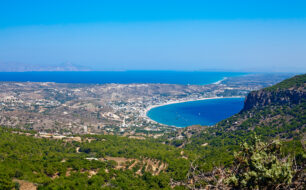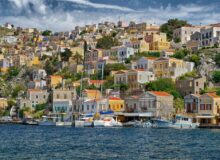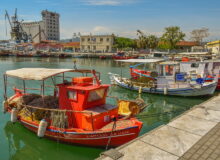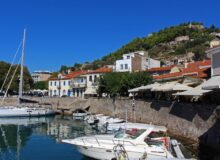The See Greece guide to the island of Kos with a brief history and travel information on how to get there by ferry or by air and what to see and do.

Introduction to Kos
Kos is one of the most popular Greek islands in the Dodecanese, located in the southeastern Aegean Sea near the coast of Turkey. It is the third-largest island in the group after Rhodes and Karpathos, known for its long sandy beaches, ancient ruins, and vibrant nightlife. Kos blends rich history with modern tourism, offering something for every traveler—whether you seek relaxation, adventure, or cultural exploration.
Where is Kos Located?

Kos lies in the southeastern part of the Aegean Sea, just 4 kilometers (2.5 miles) off the coast of Bodrum, Turkey. It is part of the Dodecanese island chain, situated between Kalymnos to the north and Nisyros to the south. The island spans approximately 290 square kilometers (112 square miles) and has a population of around 33,000 people. Its capital and main port, also called Kos Town, is a hub for ferries and flights.
A Brief History of Kos
Kos has a long and fascinating history, shaped by various civilizations over the centuries:
– Ancient Times: Inhabited since the Neolithic period, Kos flourished during the Classical and Hellenistic eras. It was a center of learning and medicine, home to the famous physician Hippocrates (460–370 BC), who founded the Asklepieion, an ancient healing temple.
– Roman & Byzantine Rule: The Romans took control in the 2nd century BC, followed by the Byzantines, who fortified the island against Arab invasions.
– Knights of St. John: In the 14th century, the Knights Hospitaller ruled Kos, constructing strong fortifications, including the Castle of Neratzia in Kos Town.
– Ottoman Era: The Ottomans occupied Kos from 1523 until 1912, leaving behind mosques and Turkish baths.
– Italian Occupation: After the Ottomans, Italy took control until 1947, when Kos finally became part of Greece.
Today, the island’s layered history is visible in its archaeological sites, medieval castles, and Ottoman architecture.

What to See and Do on Kos
1. Explore Kos Town
Kos Town is the island’s lively capital, where ancient ruins stand alongside Venetian and Ottoman landmarks. Key sights include:
– Neratzia Castle: A 15th-century fortress built by the Knights of St. John, offering panoramic sea views.
– Hippocrates’ Plane Tree: A 500-year-old tree under which Hippocrates allegedly taught his students.
– Ancient Agora: A sprawling archaeological site with Roman and Hellenistic ruins, including temples and a restored gymnasium.
– Eleftherias Square: The heart of the town, lined with cafes, bars, and restaurants.
2. Visit the Asklepieion
Located 4 km southwest of Kos Town, this ancient healing sanctuary was dedicated to Asclepius, the god of medicine. It was one of the most important medical centers of antiquity and offers stunning views of the surrounding landscape.

3. Relax on Kos’ Best Beaches
– Tigaki Beach: A long sandy beach with shallow waters, ideal for families.
– Paradise Beach: Known for its golden sand and lively beach bars.
– Marmari Beach: A quieter option with crystal-clear waters.
– Therma Beach: A unique cove with natural hot springs mixing with the sea.
4. Discover Traditional Villages
– Zia: A picturesque mountain village famous for its sunset views and traditional tavernas.
– Pyli: Home to an abandoned medieval village and the Pili Fortress.
– Antimachia: A charming inland village with a well-preserved windmill and traditional houses.
5. Take a Boat Trip
Excursions to nearby islands like Nisyros (with its active volcano), Kalymnos, or even Bodrum in Turkey are popular. Day trips to Pserimos and the uninhabited islet of Kastri are also great options.
6. Enjoy Outdoor Activities
– Cycling: Kos has an extensive network of bike paths, making it easy to explore.
– Windsurfing & Kitesurfing: The beaches of Kefalos and Mastichari are ideal for water sports.
– Hiking: Trails lead to attractions like Mount Dikeos or the Agios Theologos chapel.
7. Experience Kos’ Nightlife
Kos is known for its vibrant nightlife, particularly in Kos Town, Kardamena, and Lambi. Beach clubs, cocktail bars, and nightclubs cater to all tastes, from laid-back lounges to high-energy dance venues.

Best Time to Visit Kos
The best time to visit Kos depends on your preferences:
– Peak Season (June–August): Ideal for beach lovers and nightlife, but crowded and hot (up to 35°C / 95°F).
– Shoulder Season (May, September, October): Pleasant temperatures (20–28°C / 68–82°F), fewer crowds, and lower prices.
– Off-Season (November–April): Quiet, with cooler weather (12–18°C / 54–64°F). Some hotels and restaurants close, but it’s great for cultural exploration.

How to Get to Kos
By Air
Kos International Airport (KGS) receives seasonal flights from major European cities, as well as domestic flights from Athens (1-hour flight) and Thessaloniki. Airlines like Aegean, Ryanair, and easyJet operate routes. From the airport, taxis and buses connect to Kos Town (25 minutes) and other resorts.
By Ferry
Kos is well-connected by ferry to other Greek islands and Turkey:
– From Athens (Piraeus Port): Ferries take 8–12 hours (overnight options available).
– From Rhodes: Fast ferries take 2–3 hours.
– From Other Dodecanese Islands: Regular connections to Kalymnos, Leros, Patmos, and Symi.
– From Turkey: Daily ferries run from Bodrum (30–60 minutes).
Final Tips for Visiting Kos
– Transport: Rent a car, scooter, or bike to explore beyond the main towns.
– Local Cuisine: Try traditional dishes like pitaridia (homemade pasta), fresh seafood, and katimeria (fried cheese pies).
– Cash & Cards: Most places accept cards, but smaller villages may prefer cash.









